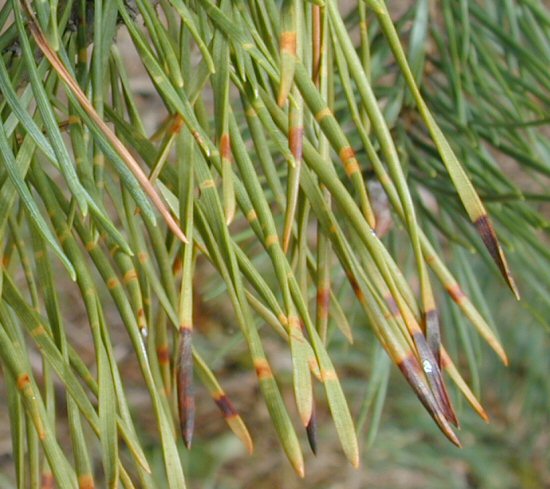
When transplanting trees, always allow for adequate spacing to promote air circulation and to help reduce infection. This needle blight has been found in native Douglas-fir trees bordering Christmas tree plantations. During drought conditions, consider a combination of watering deeply, mulching to moderate soil temperature, and properly fertilizing to optimize nutrients. Repeat the application during the wet season, when environmental conditions are conducive for fungal development. Treatment includes pruning severely affected branches and disposing of fallen needles, followed by applying an appropriate fungicide in spring. With proper treatment, there is hope for conifers infected by this fungal pathogen. The spots and bands quickly turn brown to reddish brown during the summer months.

This deep green color banding is short-lived. This disease can be difficult to control. Early symptoms of a blighted needle would be deep-green bands and yellow and tan spots on needles. Trees that lose first-year needles for several consecutive years appear thin, lose lower branches, and may eventually die. Between 15 and 18 months after infection, needles typically begin to drop. As fungi mature, rows of black fruiting bodies may appear on needles. Infected needles of other plant species typically become off-green before turning tan or brown. One of the earliest symptoms of rhizosphaera needle cast in Colorado spruce is mottled-yellow needles that progressively turn bright yellow, then purplish-pink and eventually brown.
#Needle blight in fir how to
How to Identify Rhizosphaera Needle Cast: Other conifer hosts include deodar cedar, douglas fir, true firs, hemlocks, pines and coast redwood. Many types of spruce are very susceptible to rhizosphaera needle cast, including Colorado spruce and Engelmann spruce. However, this fungal infection can affect conifers anytime during the growing season. Cool, rainy weather and long periods of leaf wetness make this a common spring condition. Prepared by Gary W.Rhizosphaera is a fungal genus that affects cone-bearing shrubs and trees throughout the Northern hemisphere. of Plant Pathology collection) From the PA Department of Natural Resources. No control is recommended for these fungi, which over-winter on the broadleaf host and then spreads to hemlock.įabrella needle blight (Penn State Dept.

Pucciniastrum hydrangeae (hemlock ↔ hydrangea) Pucciniastrum vaccinii (hemlock ↔ rhododendron and others) Melampsora abietiscanadensis (hemlock ↔ poplar) Orange-yellow spores develop on poplar leaves where the fungus over-winters. Orange-yellow spores coat the infected tissue. No control is recommended for this fungus, which only requires hemlock to complete its life cycle.Ĭurrent-season growth is slightly swollen and curled.

Twigs twist and die and have yellowish spores on them. What does Dothistroma needle blight look like Dothistroma needle blight first appears as dark green, water-soaked spots. In Wisconsin, Austrian pines are most commonly and severely affected by this disease. Generally, little damage occurs unless the tree is under other stresses such as drought or insect attack.Ĭones become covered with dusty, yellowish spores. What is Dothistroma needle blight Dothistroma needle blight is a common needle disease that can affect over thirty species of pine trees. septosporum in two ways: (1) by killing conidia (spores) released during wet periods thus protecting treated needles from infection (Franich 1988) and (2) by. Fungal fruiting structures appear as small dots on the underside of the needle, white at first but then darken, lining either side of the main vein. Needles in the lower part of the tree turn brown and fall in late summer, leaving bare twigs. Slightly sunken cankers girdle and kill branches.


 0 kommentar(er)
0 kommentar(er)
